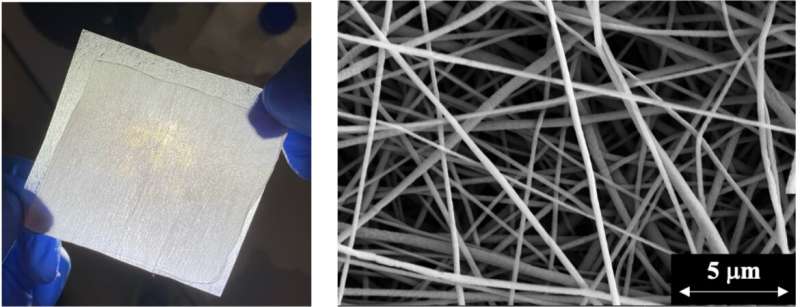Filter could curb airborne spread of COVID-19 virus

A filter made from polymer nanothreads blew three kinds of commercial masks out of the water by capturing 99.9% of coronavirus aerosols in an experiment.
"Our work is the first study to use coronavirus aerosols for evaluating filtration efficiency of face masks and air filters," said corresponding author Yun Shen, a UC Riverside assistant professor of chemical and environmental engineering. "Previous studies have used surrogates of saline solution, polystyrene beads, and bacteriophages—a group of viruses that infect bacteria."
The study, led by engineers at UC Riverside and The George Washington University, compared the effectiveness of surgical and cotton masks, a neck gaiter, and electrospun nanofiber membranes at removing coronavirus aerosols to prevent airborne transmission. The cotton mask and neck gaiter only removed about 45%-73% of the aerosols. The surgical mask did much better, removing 98% of coronavirus aerosols. But the nanofiber filter removed almost all of the coronavirus aerosols.
Studying a contagious new virus is dangerous and done in labs with the highest biosecurity ratings, which are relatively rare. To date, all studies during the pandemic on mask or filter efficiency have used other materials thought to mimic the size and behavior of coronavirus aerosols. The new study improved on this by testing both aerosolized saline solution and an aerosol that contained a coronavirus in the same family as the virus that causes COVID-19, but only infects mice.
Shen and George Washington University colleague Danmeng Shuai produced a nanofiber filter by sending a high electrical voltage through a drop of liquid polyvinylidene fluoride to spin threads about 300 nanometers in diameter—about 167 times thinner than a human hair. The process created pores only a couple of micrometers in diameter on the nanofiber's surfaces, which helped them capture 99.9% of coronavirus aerosols.
The production technique, known as electrospinning, is cost effective and could be used to mass produce nanofiber filters for personal protective equipment and air filtration systems. Electrospinning also leaves the nanofibers with an electrostatic charge that enhances their ability to capture aerosols, and their high porosity makes it easier to breathe wearing electrospun nanofiber filters.
"Electrospinning can advance the design and fabrication of face masks and air filters," said Shen. "Developing new masks and air filters by electrospinning is promising because of its high performance in filtration, economic feasibility, and scalability, and it can meet on-site needs of the masks and air filters."
The paper, "Development of electrospun nanofibrous filters for controlling coronavirus aerosols," is published in Environmental Science & Technology Letters.
More information: Hongchen Shen et al. Development of Electrospun Nanofibrous Filters for Controlling Coronavirus Aerosols, Environmental Science & Technology Letters (2021). DOI: 10.1021/acs.estlett.1c00337





















